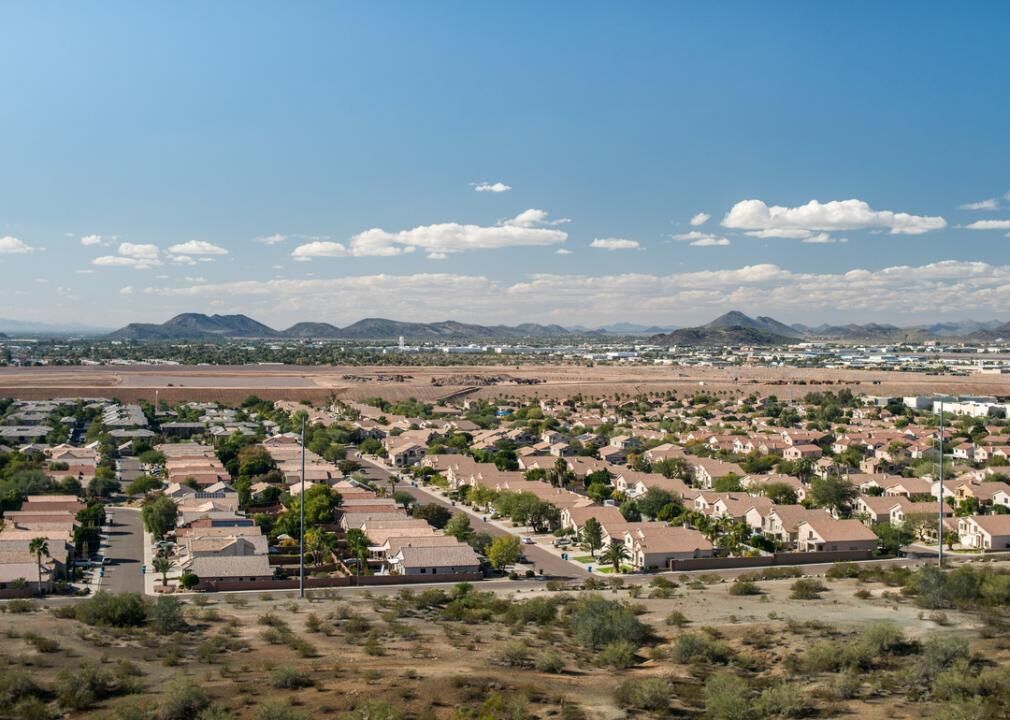PHOENIX — State water officials said Thursday they won’t issue any permits for new subdivisions for some areas on the fringes of Phoenix, the first real acknowledgment the state’s water supply cannot support all anticipated growth.
A newly completed analysis of groundwater in the basin in and around Phoenix shows there simply won’t be enough to provide the legally required 100-year supply of water, said Tom Buschatzke, director of the Arizona Department of Water Resources. State law requires such assurances in the major metropolitan areas before construction can take place.
He put the shortage at 4.9 million acre-feet over the next century, about 4% of the anticipated need. An acre-foot of water is generally considered enough to serve three families for a year.
Most immediately, the action means developers in affected areas who were awaiting the go-ahead to build won’t get it.
But nothing in the new order will bring all development in the Phoenix metro area to a halt, at least not at this point.
That’s because all existing municipal and private water companies are currently presumed to have their own 100-year supply. So anyone the utility agrees to serve, who is seeking to build homes within that service territory, is presumed to have the amount of water required and can start construction without further state approval.
But the order could bring some of the urban sprawl around Phoenix to a halt.
Affected areas include some of the largest tracts of undeveloped land in the fringe suburbs, including much of Queen Creek, which doesn’t have its own 100-year certificate of assured water supply. Instead, Queen Creek has been seeking to import water from other areas.
The same is true of a large swath of Buckeye. There are also large unincorporated areas which Buschatzke said the modeling shows cannot guarantee there will be enough groundwater beneath them to support the development for 100 years.
Buschatzke said, though, construction can take place if developers find sources beyond the water under their developments, which can range from another community’s stored water credits to obtaining an allocation of surface water, perhaps from Native American tribes who have their own water rights.
Gov. Katie Hobbs presented the new analysis as evidence there is no reason to put curbs on future growth.
“My message to Arizonans is this: We are not out of water and we will not be running out of water,’’ she said at a news conference Thursday.
“It is also incredibly important to note that the model relates only to groundwater and does not concern surface water supplies which are a significant source of renewable water for our state,’’ Hobbs said. “What the model ultimately shows is that our water future is secure.’’
But all those assurances are based on something that Buschatzke could not guarantee: that Arizona won’t see further cutbacks in its allocation of Colorado River water.
Arizona and other states in the river Lower Basin, California and Nevada, just entered into an agreement to cut usage in exchange for federal cash.
But that deal lasts only into 2026. After that, Buschatzke said, is an unknown.
“The cuts are going to be based on what the hydrology provides every year on the river and what the levels of Lake Powell and Lake Mead are,’’ he said.
Hobbs, flanked by a developer and the head of the state’s economic development agency, sought to give a message that things are not bad in Arizona despite the latest announcement.
None of this has any immediate effect on developing vacant land in communities with their own assured water supply, she noted.
The Democratic governor also said nothing in the new order affects 80,000 lots in the areas where the state won’t issue new permits. The Arizona Department of Water Resources already provided the required certificate of assured water supply. Buschatzke acknowledged that a “lot’’ can translate to more than a single family home.
Hobbs also said there are no limits on industrial development. Nor are there new restrictions on everything from fountains to golf courses that dot the Phoenix area.
Reservoirs controlled by the Salt River Project utility are full, Hobbs pointed out. While these are a source of water for agriculture in the area, SRP also has deals with cities to provide surface water.
Even with all that, there’s still the 4% gap between water pumping and recharge. or replenishment of groundwater.
“We have to close this gap and find efficiencies for our water use, manage our aquifers wisely and increase our utilization of renewable supplies,’’ Hobbs said.
She is setting aside $40 million in COVID-19 relief funds — money she took back from programs that her predecessor, Republican Gov. Doug Ducey, had allocated to others — to promote water conservation.
“This is a down payment on my commitment to building a sustainable water future,’’ Hobbs said. “It will not be a complete answer but it’s an important first step in the work we have to do.’’
The question of Colorado River supplies beyond 2026 will have an affect on not just the Phoenix area, the one that was just studied.
Other areas of the state, particularly the Tucson region, also rely on this supply. Buschatzke’s agency has no firm date for when it will perform the same evaluation of groundwater in the Tucson area — and possibly could issue similar orders for development in that basin.
Get your morning recap of today's local news and read the full stories here: http://tucne.ws/morning






